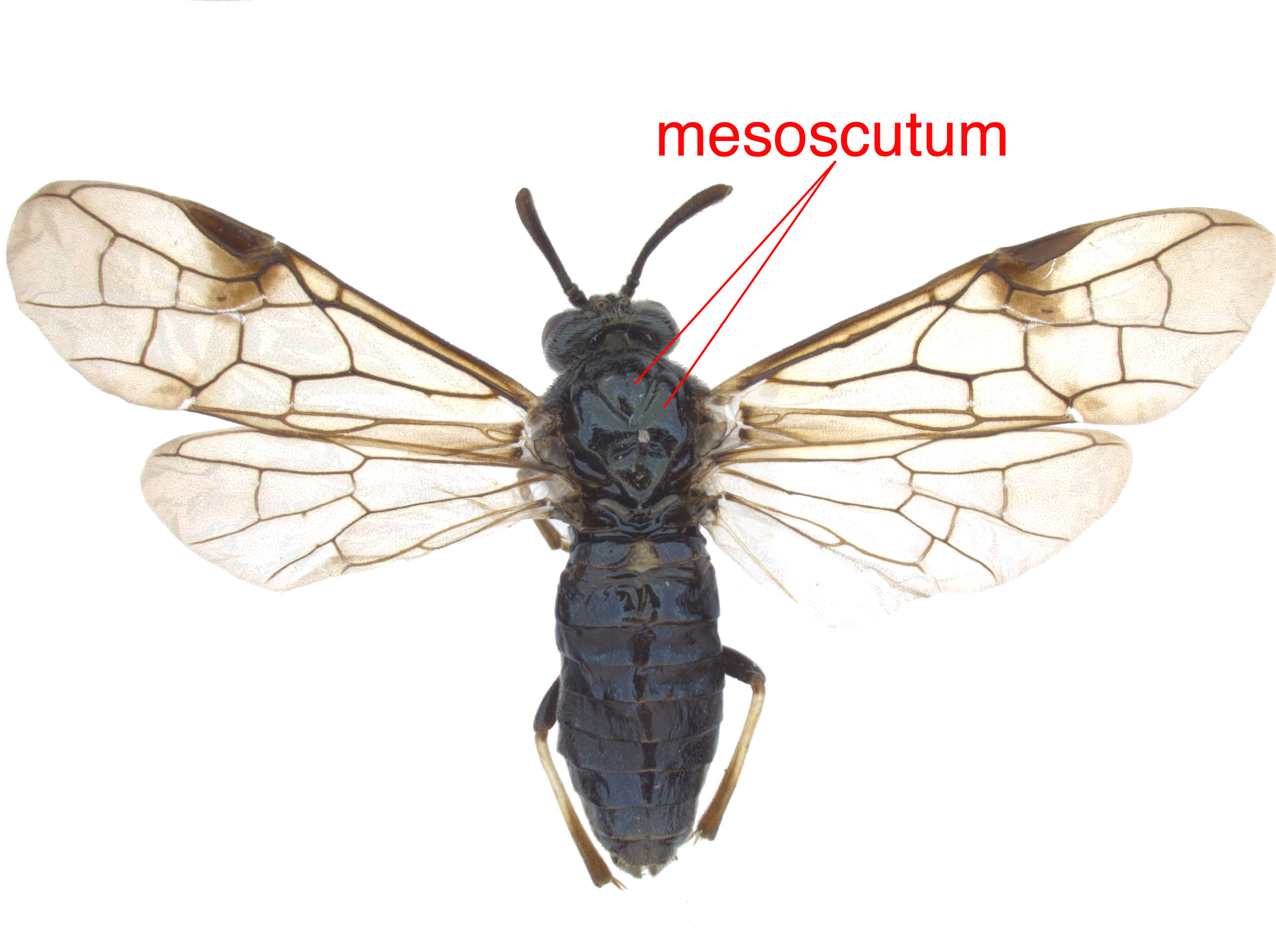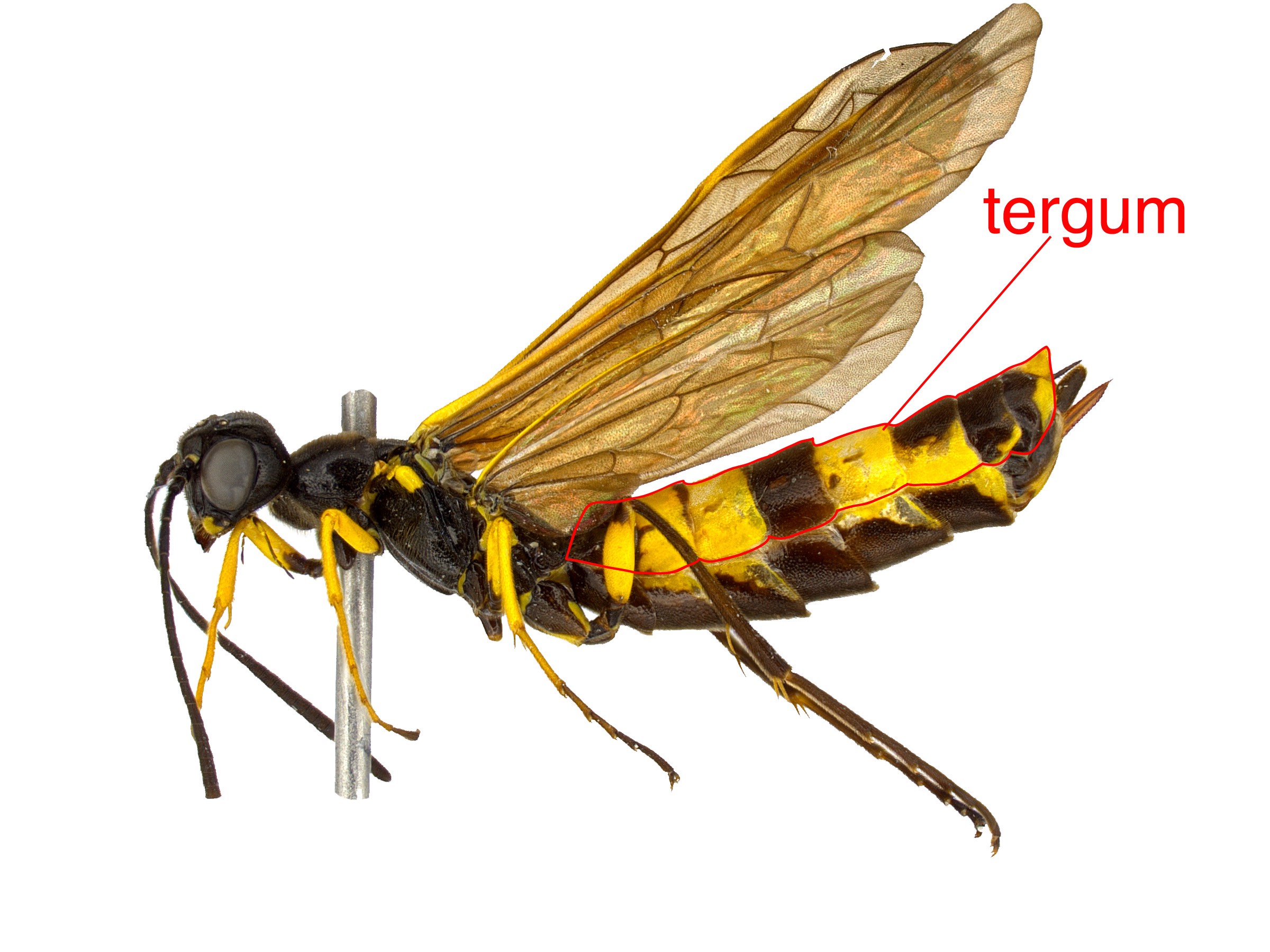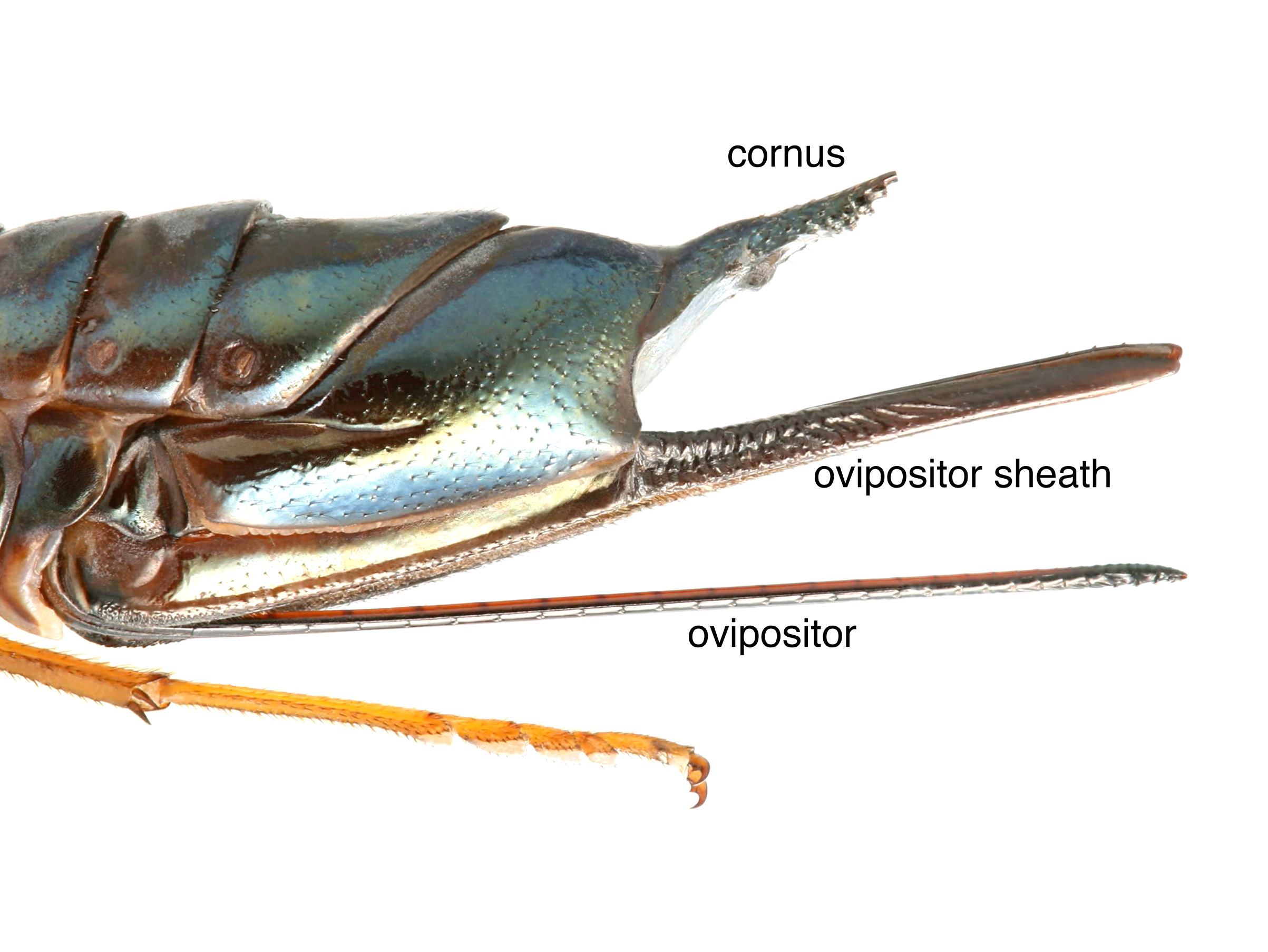In most cases, having a sawfly specimen mounted facilitates identification. Having the insect on a pin allows a user to manipulate the specimen and see diagnostic characters without touching it and risking damage to the body.
Sawflies are easiest to pin within the first 24 hours of collection or immediately after being stored in alcohol, before the body dries and becomes rigid and fragile. A stainless steel insect pin of appropriate size (0-4) should be pushed, as vertically straight as possible, through the right side of the mesoscutummesoscutum:
the central and dorsal portion of the thorax between the scutellum and postnotum
 . Because sawflies are bilaterally symmetrical, this off-center approach ensures that an undamaged “copy” of the pierced area exists on the opposite side. The insect on the pin should be generally positioned horizontally, as if it is sitting on a flat surface.
. Because sawflies are bilaterally symmetrical, this off-center approach ensures that an undamaged “copy” of the pierced area exists on the opposite side. The insect on the pin should be generally positioned horizontally, as if it is sitting on a flat surface.
When mounting sawfly specimens, it is important to make sure the wings, which are naturally positioned folded over the dorsum, are positioned so as not to obscure diagnostic wing venationvenation:
the network of veins on a wing
or body parts. This is most easily accomplished by ensuring the wings are not plastered to each other or the body while the specimen is drying. Using an insect pin to carefully lift and separate the wings while pinning the specimen can help with this. The wings are very fragile, and any such manipulation should be performed carefully. Sawfly wings can also be spread laterally, like a butterfly; this creates dramatic specimens, but isn't necessary for identification (see photos below).
Each of these positions retains visibility of the abdominal tergatergum:
the dorsal area of the abdomen
 , meta-thorax, laterallateral:
, meta-thorax, laterallateral:
of or towards the side of the body
sclerites, and complete wing venationvenation:
the network of veins on a wing
. Additionally, the legs of the specimen should be arranged along the sides (versus underneath) of the body, as symmetrically as possible. AntennaeAntenna:
the sensory organ emerging from the front of the head, usually between the compound eyes and above the clypeus; includes the flagellum, scape and pedicel
 should be somewhat straightened and separated from one another, so the segments can be clearly seen and counted, and the antennaeantenna:
should be somewhat straightened and separated from one another, so the segments can be clearly seen and counted, and the antennaeantenna:
the sensory organ emerging from the front of the head, usually between the compound eyes and above the clypeus; includes the flagellum, scape and pedicel
 don’t obscure head characters. If possible, it can also be useful to spread the mandibles and gently pull the ovipositorovipositor:
don’t obscure head characters. If possible, it can also be useful to spread the mandibles and gently pull the ovipositorovipositor:
the female organ that deposits eggs and is used to drill into plant tissue, located at the apex of the abdomen, made up of the lance and lancet
 out into view.
out into view.
Once a specimen has dried, these features can no longer be manipulated without risk of breakage. It is time consuming and challenging to re-hydrate a specimen, so it is worth the extra initial effort to prepare the specimen with the wings, legs, and antennaeantenna:
the sensory organ emerging from the front of the head, usually between the compound eyes and above the clypeus; includes the flagellum, scape and pedicel
 in position. Use small pins to hold them in place while drying occurs.
in position. Use small pins to hold them in place while drying occurs.
For small specimens (<5 mm in length), it may be necessary to point-mount or double mount to not destroy or obscure the thoraxthorax:
the second and middle segment of the body, between the head and abdomen
 (see examples of point-mounting and double mounting below).
(see examples of point-mounting and double mounting below).
Mounted specimens should be labeled with thorough information that enhances the scientific value of the specimen. A good label contains as many of the following items as are known about a specimen: collecting locality (including state/province, county, and city), geographical coordinates, date of collection, name of collector, collecting method, associated plant, and habitat or behavioral notes. The label should be placed on the pin, below the specimen.
Sawfly larvaelarva:
the immature stage of holometabolous insects
 are soft-bodied, so they need to be treated differently from adult specimens. The most common way to store larvaelarva:
are soft-bodied, so they need to be treated differently from adult specimens. The most common way to store larvaelarva:
the immature stage of holometabolous insects
 is in glass vials of 70% EtOH. Labelling is equally important with larvaelarva:
is in glass vials of 70% EtOH. Labelling is equally important with larvaelarva:
the immature stage of holometabolous insects
 . Best practice is to keep the label inside the vial with the larvaelarva:
. Best practice is to keep the label inside the vial with the larvaelarva:
the immature stage of holometabolous insects
 , which minimizes the risk of dissociation that could occur with labels affixed to the vial. Inscribe the label with archival ink so it will not be degraded by the fluid.
, which minimizes the risk of dissociation that could occur with labels affixed to the vial. Inscribe the label with archival ink so it will not be degraded by the fluid.
If you are making many observations or collections of sawflies in natural environments, especially of genera not well covered by existing literature, consider using a site like iNaturalist.org or BugGuide.net to log your specimen data. There it can be accessed by researchers and members of the public to expand knowledge of range, host associations, and seasonality.